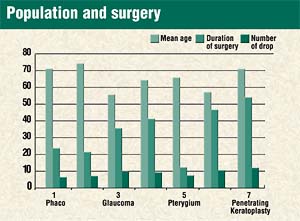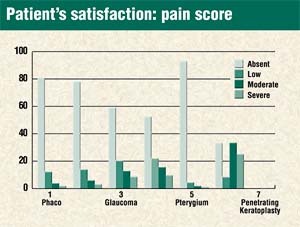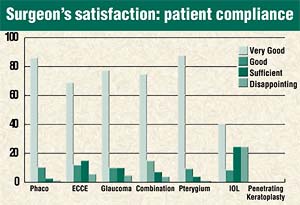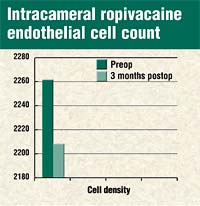Ropivacaine deserves consideration as topical anesthetic, surgeon says
CASSINO, Italy – Topical anesthesia with ropivacaine 1% is safe, effective and low in cost, according to Silvio Savastano, MD, of the Cassino Eye Clinic.
“We have been using it for over 4 years in cataract surgery, in glaucoma and even in one case of penetrating keratoplasty. Results have been very good, and I believe that this anesthetic deserves far more consideration,” he said.
The advantages of topical anesthesia presently are largely recognized.
“It is free of all the major complications of other methods, and it is far less stressful for the patient,” he said.
The only disadvantage is the drug’s short duration of action, which can easily be overcome by reinforcing its effect with additional doses administered in the course of surgery.
Effective pain control
Lidocaine is by far the most commonly used topical anesthetic, while ropivacaine, which is an amidoamide similar to bupivacaine, is rarely employed.
“Among 1,857 publications on anesthetics reviewed in a study which recently appeared in Ophthalmology, none reported the use of ropivacaine,” Dr. Savastano said.
In his opinion, Naropin (ropivacaine, Astra) is even more effective than lidocaine.
“We are about to publish a study where the effects of lidocaine 2% are compared to those of ropivacaine 1% in phacoemulsification, and this will prove that ropivacaine gives better, more long-lasting control of pain and requires a lower number of instillations,” he said.
Unpreserved ropivacaine is sold in sterile 10-mL blisters. One blister fills 10 syringes, which can be used at a dose of 1 cc for 10 patients.
“The substance has very low neurologic and cardiac toxicity, prolonged anesthetic and analgesic effects and low cost,” he said.
He recommends an instillation every 5 minutes for a total of 20 minutes preoperatively. An additional drop can be instilled after the blepharostat has been applied and when the incision is en larged for IOL insertion. One or two more drops can be used if the patient complains of some discomfort.
Exclusion criteria are very few, he said.
“Only rare cases of intolerance to topical anesthetics, de m entia, deafness and un controlled eye move ment are excluded. Now we use this type of anesthesia with all our patients.”
Large number of cases
The results were based on a large number of patients treated at the eye clinics of Cassino and Benevento during a 4-year period. The study encompassed 4,325 cases of phaco with IOL implant, 138 extracapsular cataract extraction with IOL implant, 94 cases of glaucoma surgery (67 deep sclerectomies and 27 trabeculectomies), 187 combined phaco-trabeculectomies or phaco-deep sclerectomies, 350 removals of pterygium, 12 implantations of scleral-fixated IOLs and one penetrating keratoplasty (PK). This made a total of seven groups.
Mean age of the patients, duration of surgery and number of drops for each group are reported in chart 1 in the order mentioned above.
Chart 2 shows the degree of pain experienced by the patient.
“The percentage of patients who experienced no pain was quite high, and there were only very few cases of severe pain, which required other types of anesthesia,” Dr. Savastano said.
Surgeon’s satisfaction was graded according to his perception of patient’s compliance during surgery (chart 3).
“There was a good compliance in all groups. Results with the PK patient are not reported in the diagram because it was a single case, but the patient was calm and cooperative,” he said.
Anesthetic-related intraoperative complications were rare. There were 93 cases (1.82%) of severe pain, which required supplementary anesthesia by intracameral (58 cases) or sub-Tenon’s injection (35 cases).
A mild epithelial edema appeared in 413 patients (8.1%), but only a few of these patients experienced discomfort from it during surgery.
The endothelial cell count of patients who were given supplementary intracameral anesthesia remained almost unaltered, with a nonsignificant loss of endothelial cells (chart 4).
“Cell density was 2,273 ± 376 before surgery and 2,208 ± 334 at 3 months after surgery,” Dr. Savastano said.
    |
For Your Information:Reference:
- Silvio Savastano, MD, can be reached at Via Rossini 60, 03043 Cassino (FR), Italy; +(39) 0776-311162; fax: +(39) 0776-21049; e-mail: silvio.savastano@tin.it.
- Friedman D, Bass E, et al. The methodologic quality of clinical trials on regional anesthesia for cataract surgery. Ophthalmology. 2001;108:530-541.
